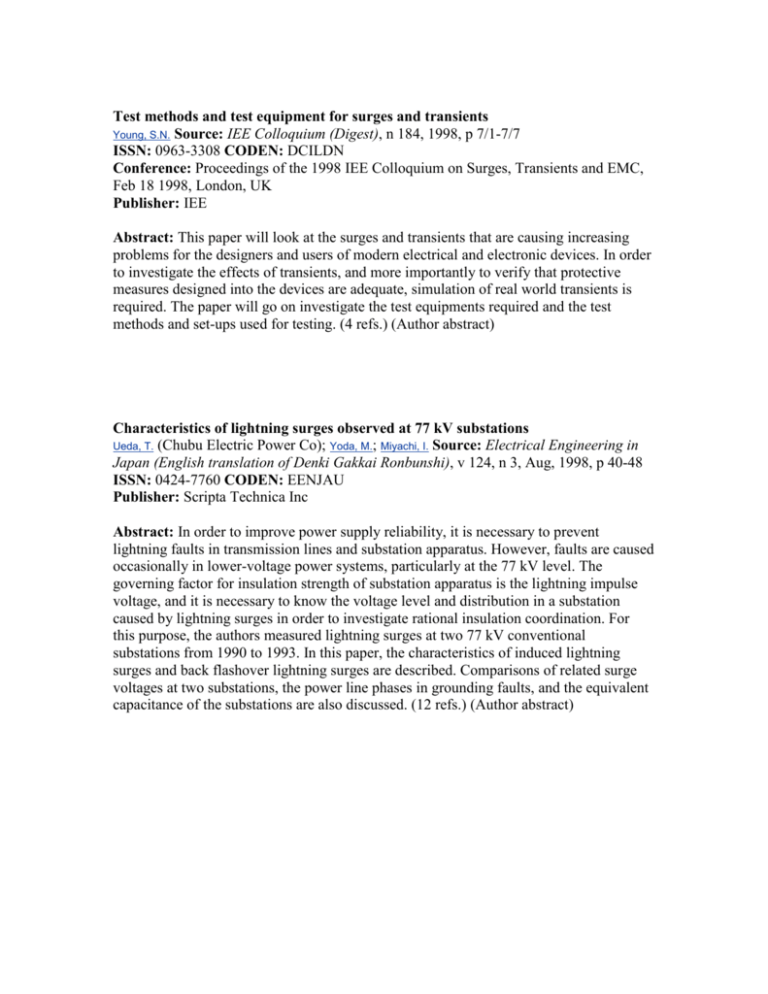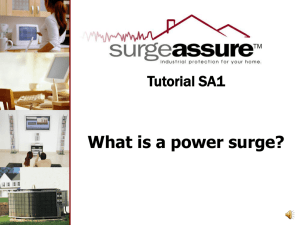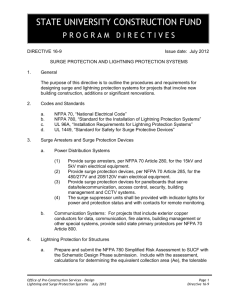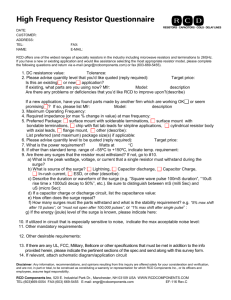References
advertisement

Test methods and test equipment for surges and transients Young, S.N. Source: IEE Colloquium (Digest), n 184, 1998, p 7/1-7/7 ISSN: 0963-3308 CODEN: DCILDN Conference: Proceedings of the 1998 IEE Colloquium on Surges, Transients and EMC, Feb 18 1998, London, UK Publisher: IEE Abstract: This paper will look at the surges and transients that are causing increasing problems for the designers and users of modern electrical and electronic devices. In order to investigate the effects of transients, and more importantly to verify that protective measures designed into the devices are adequate, simulation of real world transients is required. The paper will go on investigate the test equipments required and the test methods and set-ups used for testing. (4 refs.) (Author abstract) Characteristics of lightning surges observed at 77 kV substations Ueda, T. (Chubu Electric Power Co); Yoda, M.; Miyachi, I. Source: Electrical Engineering in Japan (English translation of Denki Gakkai Ronbunshi), v 124, n 3, Aug, 1998, p 40-48 ISSN: 0424-7760 CODEN: EENJAU Publisher: Scripta Technica Inc Abstract: In order to improve power supply reliability, it is necessary to prevent lightning faults in transmission lines and substation apparatus. However, faults are caused occasionally in lower-voltage power systems, particularly at the 77 kV level. The governing factor for insulation strength of substation apparatus is the lightning impulse voltage, and it is necessary to know the voltage level and distribution in a substation caused by lightning surges in order to investigate rational insulation coordination. For this purpose, the authors measured lightning surges at two 77 kV conventional substations from 1990 to 1993. In this paper, the characteristics of induced lightning surges and back flashover lightning surges are described. Comparisons of related surge voltages at two substations, the power line phases in grounding faults, and the equivalent capacitance of the substations are also discussed. (12 refs.) (Author abstract) Modelling of a 500kV transmission tower for lightening surge analysis Hara, Takehisa (Kyoto Univ); Yamamoto, Osamu; Hayashi, Muneaki Source: Memoirs of the Faculty of Engineering, Kyoto University, v 55, n pt 3, Jul, 1993, p 103-115 ISSN: 0023-6063 CODEN: MEKYAC Abstract: Modeling of transmission towers is an essential part of the traveling analysis of lightning surges in overhead power transmission lines. In this paper, an equivalent distributed constant line model of the transmission tower is developed. The model consists of three parts: main poles, lattices and crossarms. The surge impedance of each part is expressed by the functions of their dimensions and geometries. This tower model is applied to the 500kV transmission tower of which surge performance characteristics are measured. It is found that the tower voltage wave shapes calculated from this model closely agree with the measured ones. This proves that the authors' proposed tower model well simulates the surge performances of an actual transmission tower. (12 refs.) (Author abstract) Surge protection and grounding Goodland, Richard (Quality of Supply Technologies) Source: Vector (Electrical Engineering), Oct, 1998, 2pp ISSN: 0256-7008 CODEN: VECTDP Publisher: Pulse Publ (Pty) Ltd Abstract: When lightning strikes, effective surge suppressions is necessary. For really effective surge suppression, three things should be considered. First, the earth and neutral must be securely bonded at the entrance to a facility. Second, if the voltage between earth and neutral approaches 2 V peak-peak, the band must be re-established using an isolating transformer. Third, a decent surge suppressor must be connected between live and neutral at the facility entrance. By considering these important points, the user can be certain that the surge protection system is effective, and that the continued use of the equipment being protected, is assured. Surge protection for electronic equipment Respondek, Peter (Dehn & Sohne); Standler, Ronald B. Source: Compliance Engineering, v 12, n 6, Sep-Oct, 1995, p 47-52 ISSN: 0898-3577 CODEN: CENGE3 Publisher: Compliance Engineering Abstract: The Lightning Protection Zone Concept is a new technique which offers a comprehensive protection against the effects of lightning and other surges. It is a 3-D planning and construction method that incorporates principles of electromagnetic compatibility into a simple and easy-to-follow set of rules. In this technique, the interface between adjacent building zones must encompass both (1) shielding, to attenuate radiated electromagnetic fields, and (2) appropriate surge-protective devices and electrical filters on all electrical conductors that connect discrete zones, to attenuate conducted transient overvoltages and noise. (5 refs.) Study on increasing the surge capability of a lightning surge protection semiconductor device Satoh, Hidetaka (NTT Appl Electron Lab, Musashino-Shi, Tokyo, Japan) Source: IEEE International Symposium on Electromagnetic Compatibility, Dec, 1991, p 469-473 ISSN: 0190-1494 CODEN: IISPDC Conference: 1991 IEEE International Symposium on Electromagnetic Compatibility, Aug 12-16 1991, Cherry Hill, NJ, USA Sponsor: IEEE Electromagnetic Compatibility Soc; IEEE Philadelphia Section, 92050495198 Publisher: Publ by IEEE Abstract: Design techniques for increasing the surge capability of a bidirectional SCR (silicon controlled rectifier) lightning surge protection device for communications equipment are described. The relationships between surge capability and doping profiles with different p-base widths and n-base impurity concentrations are studied by analyzing failure modes and surge response characteristics. A narrow p-base width is effective for increasing surge capability because it can reduce turn-on energy dissipation that leads to hot-spot failure. Furthermore, reducing the on-state energy dissipation can increase surge capability without increasing device size. (13 refs.) Transient voltage surge protection Shrive, Charles A. Source: Construction Specifier, v 49, n 3, Mar, 1996, p 19-20 ISSN: 0010-6925 CODEN: COSPAJ Publisher: Construction Specifications Inst Inc Abstract: Transient voltages inflict damages on sensitive equipments. Such damages can be prevented or even eliminated. There are two possible ways of achieving this. One is to consider IEEE Standard 1100 which is considered as an excellent resource for designers and specifiers attempting to identify and solve problems associated with designing to minimize transient voltage surges. The other is to install appropriately selected surge protection devices (SPDs) or transient voltage surge suppressors (TVSS).






